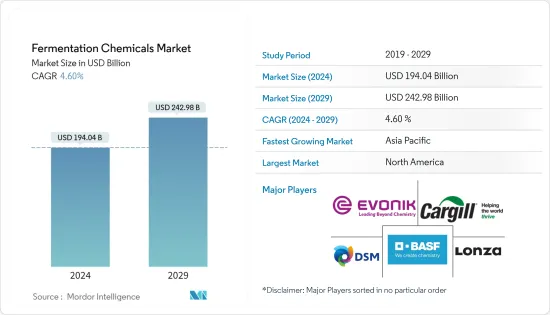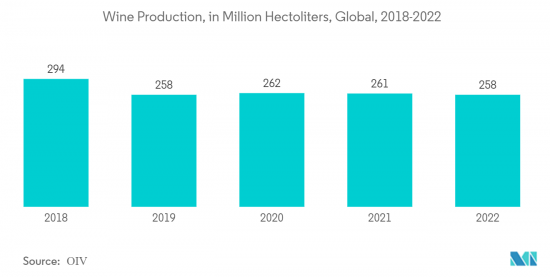 |
市场调查报告书
商品编码
1404106
发酵化学品-市场占有率分析、产业趋势与统计、2024年至2029年成长预测Fermentation Chemicals - Market Share Analysis, Industry Trends & Statistics, Growth Forecasts 2024 - 2029 |
||||||
※ 本网页内容可能与最新版本有所差异。详细情况请与我们联繫。
发酵化学品市场规模预计到2024年为1,940.4亿美元,预计到2029年将达到2,429.8亿美元,在预测期内(2024-2029年)复合年增长率为4.60%。

COVID-19大流行对发酵化学品市场产生了负面影响。然而,市场在2021年显着復苏。
主要亮点
- 短期来看,甲醇和乙醇产业需求的增加以及製药业需求的增加是推动所研究市场成长的关键因素。
- 然而,由于製造流程复杂性导致的高成本可能会限制市场成长。
- 然而,随着生态化学机会的增加,全球市场很快就会出现利润丰厚的成长机会。
- 北美地区主导发酵化学品市场,美国、加拿大和墨西哥等国家的消费量最大。
发酵化学品市场趋势
食品和饮料产业主导市场
- 发酵通常意味着需要微生物作用。发酵产生酒精饮料,如葡萄酒、啤酒和苹果酒。发酵也用于乳製品生产和麵包发酵。
- 食品和饮料行业对发酵化学品的需求量很大,因为它们是人类用来生产更安全、更稳定和更好的食品的最古老的生物技术。
- 在亚太地区,由于生活方式的改变、人们的可支配收入、速食以及对食品的偏好,对加工食品的需求正在增长。消费者更喜欢已调理食品的准备时间要少得多,而且新鲜,而且包装美观、坚固。
- 此外,预计中国仍将是亚洲最大的食品市场,印度和东南亚的食品支出成长最为强劲。
- 由于人们对包装食品的过度依赖以及食品加工公司的强大立足点,北美食品加工市场十分强劲。百事可乐、泰森食品和雀巢是该地区主要的食品加工公司。
- 德国是欧洲最大的食品和饮料市场,拥有超过 8,300 万消费者,是世界上最富有的消费者。 2023年,德国食品市场预计销售额将达2,455亿美元。预计2023年至2027年该市场将以每年3.64%的速度成长。
- 根据 OIV(国际葡萄与葡萄酒组织)的数据,2022 年全球葡萄酒产量约为 2.58 亿百公升。
- 此外,2022年,义大利是全球最大的葡萄酒生产国,也是葡萄酒出口最多的国家,出口量为2,190万公升。最大的出口国是另外两个主要葡萄酒生产国。法国出口量为 1,400 万百升,西班牙出口量为 2,120 万公升。
- 这些因素可能会支持食品和饮料领域的研究市场需求。

北美市场占据主导地位
- 北美目前在全球发酵化学品市场中占有最高份额。
- 在美国,製药业是北美市场的主要动力,正着力转型为生态产业。
- 在北美地区,美国占据全球药品销售收益的最大份额。据阿斯特捷利康称,到 2024 年,美国预计将在药品上花费 6,050 亿至 6,350 亿美元。
- 加拿大医药市场排名全球第九,占全球市场销售额的2.1%。加拿大的製药业在政府的直接支持下正在取得进展。例如,2021 年 8 月,加拿大政府宣布对糖尿病研究进行新投资。
- 最近,美国食品和饮料行业经历了显着增长,这可能会推动市场研究。
- 2022年3月,雀巢宣布计画在美国亚利桑那州凤凰城投资6.75亿美元,生产燕麦奶咖啡奶精等饮料。该工厂计划于 2024 年运作。
- 此外,加拿大和墨西哥对製药、食品和食品和饮料行业使用的发酵化学品的需求也在增加。
- 因此,上述因素导致预测期内北美发酵化学品市场的需求不断增加。
发酵化学品产业概况
全球发酵化学品市场部分整合。主要参与企业包括(排名不分先后)BASF股份公司、嘉吉公司、赢创工业股份公司、帝斯曼和龙沙。
其他福利:
- Excel 格式的市场预测 (ME) 表
- 3 个月的分析师支持
目录
第一章简介
- 调查先决条件
- 调查范围
第二章调查方法
第三章执行摘要
第四章市场动态
- 促进因素
- 甲醇和乙醇产业需求不断成长
- 製药业需求增加
- 其他司机
- 抑制因素
- 製造流程复杂,成本高
- 其他阻碍因素
- 产业价值链分析
- 波特五力分析
- 供应商的议价能力
- 买方议价能力
- 新进入者的威胁
- 替代品的威胁
- 竞争程度
第五章市场区隔(以金额为准的市场规模)
- 产品类别
- 酒精
- 有机酸
- 酵素
- 其他产品类型
- 目的
- 工业的
- 食品和饮料
- 药品/营养品
- 塑胶和纤维
- 其他用途
- 地区
- 亚太地区
- 中国
- 印度
- 日本
- 韩国
- 东南亚国协
- 其他亚太地区
- 北美洲
- 美国
- 加拿大
- 墨西哥
- 欧洲
- 德国
- 英国
- 义大利
- 法国
- 欧洲其他地区
- 南美洲
- 巴西
- 阿根廷
- 南美洲其他地区
- 中东/非洲
- 沙乌地阿拉伯
- 南非
- 中东和非洲其他地区
- 亚太地区
第六章竞争形势
- 併购、合资、联盟、协议
- 市场占有率(%)**/排名分析
- 主要企业策略
- 公司简介
- AB Enzymes
- Ajinomoto Co., Inc.
- ADM
- BASF SE
- Biocon
- BioVectra
- Cargill, Incorporated.
- Chr. Hansen Holding A/S
- DSM
- Evonik Industries AG
- Lonza
- MicroBiopharm Japan Co., Ltd.
- Novasep
- Novozymes
- Teva Pharmaceutical Industries Ltd.
第七章 市场机会及未来趋势
- 生态化学的成长机会
- 其他机会

The Fermentation Chemicals Market size is estimated at USD 194.04 billion in 2024, and is expected to reach USD 242.98 billion by 2029, growing at a CAGR of 4.60% during the forecast period (2024-2029).
The COVID-19 pandemic negatively impacted the fermentation chemicals market. However, the market recovered significantly in 2021.
Key Highlights
- Over the short term, the growing demand from the methanol and ethanol industry and increasing demand from the pharmaceutical industry are major factors driving the studied market's growth.
- However, high costs due to the complexity involved in the manufacturing process are likely to restrain the growth of the studied market.
- Nevertheless, growing green chemistry opportunities will likely create lucrative growth opportunities for the global market soon.
- The North American region dominates the fermentation chemicals market, with the largest consumption coming from countries like the United States, Canada, and Mexico.
Fermentation Chemicals Market Trends
Food and Beverage Sector to Dominate the Market
- Fermentation usually signifies that the action of microorganisms is desirable. Fermentation produces alcoholic beverages such as wine, beer, and cider. Fermentation is also used to produce dairy products and leavening bread.
- Fermentation chemicals are highly demanded by the food and beverages industry as it is the oldest biotechnology used by human beings to produce safer, more stable, and better foodstuff.
- In the Asia-Pacific region, the demand for processed food is growing due to increasing lifestyle changes, disposable income of people, working professionals, and preferences for fast food. Consumers prefer ready-to-eat foods as these require considerably lesser time for cooking, are fresh, and include attractive and sturdy packaging.
- Also, China is expected to continue to be Asia's largest food market, and India and Southeast Asia will witness the most significant increases in food spending.
- The market for food processing in North America is robust due to the excessive dependence of people on packaged food products and the strong foothold of the food processing companies. PepsiCo, Tyson Foods, and Nestle are large food processing companies operating in the region.
- Germany is by far Europe's largest market for foods and beverages, home to more than 83 million of the world's wealthiest consumers. In 2023, the German food market is expected to generate USD 245.50 billion in revenue. The market is expected to grow annually by 3.64% between 2023 to 2027.
- According to OIV (International Organisation of Vine and Wine), global wine production in 2022 amounted to about 258 million hectoliters.
- Additionally, in 2022, Italy was the world's top wine producer and exported the most wine, amounting to 21.9 million hectoliters. The top exporters were the other two top wine producers. France exported 14 million hectoliters, while Spain exported 21.2 million.
- Such factors likely support the demand for the studied market from the food and beverages segment.

North America to Dominate the Market
- North America currently accounts for the highest global fermentation chemicals market share.
- The pharmaceutical industry highly drives the market for North America in the United States and its growing focus to turn itself into a green industry.
- In North America, the United States accounts for the largest share of the revenue generated by global pharmaceutical sales. In 2024, the United States is projected to spend between USD 605 and 635 billion on medicines, according to AstraZeneca. It will make the country achieve the highest pharmaceutical spending by far.
- Canada's pharmaceuticals market is the ninth-largest globally, with a 2.1% share of global market sales. The pharmaceutical sector in Canada is progressing under direct support from the government. For instance, in August 2021, the government of Canada announced new investments in diabetes research.
- Recently, the food & beverage industry witnessed major growth in the United States, likely to drive the market studied.
- In March 2022, Nestle announced its plans to invest USD 675 million in a new plant in Metro Phoenix, Arizona, the United States, to produce beverages, including oat milk coffee creamers, as consumer demand for plant-based products increases. The plant is expected to be operational in 2024.
- Additionally, there is an increasing demand for fermentation chemicals from Canada and Mexico for use in the pharmaceutical, food & beverage industries.
- Therefore, the abovementioned factors contribute to the increasing demand for the fermentation chemicals market in North America during the forecast period.
Fermentation Chemicals Industry Overview
The global fermentation chemicals market is partially consolidated in nature. The major players include BASF SE, Cargill, Incorporated., Evonik Industries AG, DSM, and Lonza, among others (not in any particular order).
Additional Benefits:
- The market estimate (ME) sheet in Excel format
- 3 months of analyst support
TABLE OF CONTENTS
1 INTRODUCTION
- 1.1 Study Assumptions
- 1.2 Scope of the Study
2 RESEARCH METHODOLOGY
3 EXECUTIVE SUMMARY
4 MARKET DYNAMICS
- 4.1 Drivers
- 4.1.1 Growing Demand from Methanol and Ethanol Industry
- 4.1.2 Increasing Demand from the Pharmaceutical Industry
- 4.1.3 Other Drivers
- 4.2 Restraints
- 4.2.1 High Cost Due to the Complexity Involved in the Manufacturing Process
- 4.2.2 Other Restraints
- 4.3 Industry Value Chain Analysis
- 4.4 Porter's Five Forces Analysis
- 4.4.1 Bargaining Power of Suppliers
- 4.4.2 Bargaining Power of Buyers
- 4.4.3 Threat of New Entrants
- 4.4.4 Threat of Substitute Products and Services
- 4.4.5 Degree of Competition
5 MARKET SEGMENTATION (Market Size in Value)
- 5.1 Product Type
- 5.1.1 Alcohols
- 5.1.2 Organic Acids
- 5.1.3 Enzymes
- 5.1.4 Other Product Types
- 5.2 Application
- 5.2.1 Industrial
- 5.2.2 Food and Beverage
- 5.2.3 Pharmaceutical and Nutritional
- 5.2.4 Plastics and Fibers
- 5.2.5 Other Applications
- 5.3 Geography
- 5.3.1 Asia-Pacific
- 5.3.1.1 China
- 5.3.1.2 India
- 5.3.1.3 Japan
- 5.3.1.4 South Korea
- 5.3.1.5 ASEAN Countries
- 5.3.1.6 Rest of Asia-Pacific
- 5.3.2 North America
- 5.3.2.1 United States
- 5.3.2.2 Canada
- 5.3.2.3 Mexico
- 5.3.3 Europe
- 5.3.3.1 Germany
- 5.3.3.2 United Kingdom
- 5.3.3.3 Italy
- 5.3.3.4 France
- 5.3.3.5 Rest of Europe
- 5.3.4 South America
- 5.3.4.1 Brazil
- 5.3.4.2 Argentina
- 5.3.4.3 Rest of South America
- 5.3.5 Middle-East and Africa
- 5.3.5.1 Saudi Arabia
- 5.3.5.2 South Africa
- 5.3.5.3 Rest of Middle-East and Africa
- 5.3.1 Asia-Pacific
6 COMPETITIVE LANDSCAPE
- 6.1 Mergers and Acquisitions, Joint Ventures, Collaborations, and Agreements
- 6.2 Market Share (%) **/Ranking Analysis
- 6.3 Strategies Adopted by Leading Players
- 6.4 Company Profiles
- 6.4.1 AB Enzymes
- 6.4.2 Ajinomoto Co., Inc.
- 6.4.3 ADM
- 6.4.4 BASF SE
- 6.4.5 Biocon
- 6.4.6 BioVectra
- 6.4.7 Cargill, Incorporated.
- 6.4.8 Chr. Hansen Holding A/S
- 6.4.9 DSM
- 6.4.10 Evonik Industries AG
- 6.4.11 Lonza
- 6.4.12 MicroBiopharm Japan Co., Ltd.
- 6.4.13 Novasep
- 6.4.14 Novozymes
- 6.4.15 Teva Pharmaceutical Industries Ltd.
7 MARKET OPPORTUNITIES AND FUTURE TRENDS
- 7.1 Growing Opportunities for Green Chemistry
- 7.2 Other Opportunities













